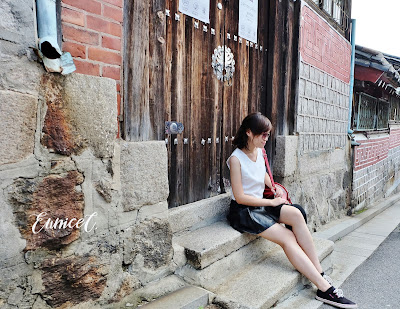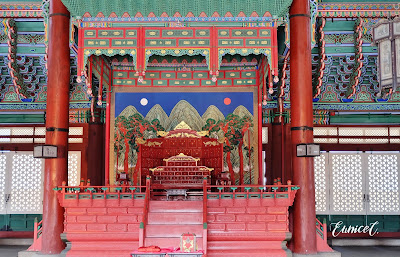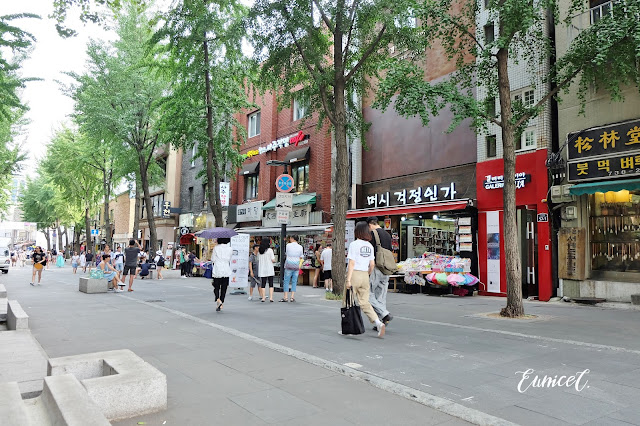It was only our second day in Seoul and we were looking forward to the plans we had for the rest of the day! If you missed our adventures on the first day in this exciting metropolitan city, here’s a link to it!
Bukchon Hanok Village
We began our adventures by travelling back to the ancient times of the Joseon dynasty. Located in the middle of a bustling city, Bukchon Hanok
village showed us the traditional side of Korea. It feels
amazing to travel back in time to a different era…sounds like a typical Korean
storyline, doesn’t it?


Similar to the
Jeju Folk Village, the Bukchon Hanok Village offers a glimpse into the
historical settings and vibes of the prominent dynasty in Korea. This quaint
neighbourhood houses hundreds of Korean traditional residences, known as Hanok.
It lies at the north of two iconic sites in Seoul, Cheonggyecheon Stream and
Jongno, giving the name, Bukchon, which literally translates to “northern
village”. Formerly resided by
aristocrats, Bukchon Hanok village is well preserved and now, many hanoks were
converted into restaurants, guesthouses, and teahouses, giving visitors a whole
new Korean experience.
We walked through the busy passageway filled
with boisterous tourists while admiring the neatly arranged rows of hanoks at
both sides. The steep passageway brought us to the top of the slope where you
can observe a picturesque view of the village. Along the way, we could not
resist to take pictures of the beautiful wall designs and antique wooden doors.
Address:
37, Gyedong-gil, Jongno-gu, Seoul
How
did we get there?
Anguk
Station (Seoul Subway Line 3), Exit 2. Go straight for about 300m to arrive at
Bukchon Hanok Village. You may enquire at the information counter for more
suggestions on the route.
No
admission fee
While on our way to Gyeongbokgung, we saw a group of crew filming a scene!
Gyeongbokgung Palace
Continuing with our odyssey in the Joseon
dynasty, we came across an ancient royal palace surrounded by high walls,
established majestically in the heart of the country’s capital. Built in the 14th
century, Gyeongbokgung served as the main palace during Joseon dynasty. Also
located far north from the two points of interest which are Changdeokgung
(Eastern Palace) and Gyeonghuigung (Western Palace) Palace, Gyeongbokgung is
colloquially known as the Northern Palace. Looks like we had been going up to
the north, on the quest of meeting the King of the North!
Entering from Gwanghwamun Gate, the main entrance of the palace, we were welcomed by the palace guards who were getting ready for a performance. It seems like we were just in time for the royal guard changing ceremony. This ceremony is scheduled twice daily in front of Gwanghwamun at 10 am & 2pm except on Tuesdays. Back then, the palace guards of Gyeongbokgung had day and night shifts. Thus, the changing of palace guards ceremony was performed once a shift was over.



Besides the changing of palace guards, you may even want to witness other performances as well.
The schedule is as following:
Gwanghwamun Gate Guard-on-Duty Performance
11:00, 13:00 / 10 minutes per ceremony
Sumungun (Gatekeeper) Military Training (outside Hyeopsaengmun Gate)
09:30, 13:30 / 15 minutes per ceremony
The reenactment of the ceremony gave us a little insight of the monarchy era in Seoul. We then proceeded to the ticketing booth situated on the far right of the palace compound. More ticketing information will be stated below. However, if you enter the palace donning a hanbok, a Korean traditional wear, you are eligible for free admission! You can even get the most out of the Joseon experience. Korean drama fanatics could also reenact a melodramatic scene from Dong Yi. Alright, that’s the only Korean drama I know which was set during the times of the Joseon dynasty.

We did not rent hanbok from elsewhere because
you can get to try it at a booth in front of Gyeonghoeru pavilion in
Gyeongbokgung Palace. In addition, you may even try on the palace guard’s
uniform. Unfortunately, we missed the chance as we were supposed to register
earlier and wait for our turn at the Traditional
Costume Experience kiosk. But it was too late for that. Oh well.
Address:
161, Sajik-ro, Jongno-gu, Seoul
How
did we get there?
Line 3
(Orange) to Gyeongbokgung & Exit 5 (through ancient palace like corridor)
Operating
hours:
November-February 09:00-17:00
March-May 09:00-18:00
June-August 09:00-18:30
September-October 09:00-18:00
* Last admission: 1 hr before closing
* Operating hours are subject to change
depending on conditions or circumstances.
*closed on Tuesdays
Admission
fee:
[Korean Citizens]
Adults (ages 25-64): 3,000 won / Groups (10
people or more): 2,400 won
[International Visitors]
Adults (ages 19-64): 3,000 won / Groups (10
people or more): 2,400 won
Children (ages 7-18): 1,500 won / Group (10
people or more): 1,200 won
Insadong
Calling for all artsy people, this place is heaven for y'all! Located 15 minutes away from Gyeongbokgung,
Insadong is a well-known cultural and artistic hub of Seoul. Insadong had
earned its recognition as a cultural centre a few hundred years ago. In
addition to the deep rooted history of the street, Insadong was known for having a school for painters back then.
To date, it remains as a focal point for art
enthusiasts, offering a variety of artworks
such as earthenware, calligraphy materials, antique furnitures, souvenirs, and
dainty accessories. There were even valuable relics such as ceramics, antique
books, and white pottery from the Joseon period where its value can go up to a
few hundred million won. Besides, many Hanbok rental shops were clustered in this
area. In the midst of the crowd, you may even see a Korean girl clad in the
fancy and vibrant looking traditional wear while lifting up a promotional sign,
calling the passersby, particularly tourists, for a Hanbok experience.
Insadong is also a perfect place for souvenir
hunting! You needn’t have to worry about getting something that represents
South Korea for your friends and relatives who were eagerly expecting them back
home. There are many shops that sell the exact same items with
same designs and prices along the street. You may
be spoilt for choices as the souvenirs come
in various types ranging from keychains, nail clippers, metal chopsticks to
traditional Korean paper fans. The prices were pretty much reasonable and
ranged from 8000 won (~RM28.32)- 20 000 won (~RM70.8), depending on the items.
We had a light stroll along the streets of
Insadong till we reached an artsy and modern complex. Ssamziegil consists of
cafes, art galleries, and even workshops under one roof. This complex features
a more contemporary side of Insadong. You may find benches and structures
creatively modelled from recycled items and brilliantly adorable murals painted
on the walls, giving a lively spirit to the place.
As dinner time was approaching, we stumbled
upon Tofu restaurant, a restaurant which its main specialty is tofu dishes. All
of us ordered seafood tofu individually, which
was served in claypot.
The hot bubbling soup was cooked with large pieces of
soft tofu, prawns, and egg, finished with spring onions. This delicious broth is eaten with rice, or soaked with rice, according to personal preference.
The main course was paired with the accompanying sides, which were gosari namul
(fernbreak), spinach, kimchi, and yangnyeom gejang (spicy raw crabs which we
were too skeptical to try!)
Personally, I do not enjoy tofu generally, even
when it is cooked in a soup form. But, this dish
surprisingly pleased my taste buds. Probably because the soup was sufficiently
seasoned with flavours, complementing the plain tofu taste.
Address: 62, Insadong-gil, Jongno-gu, Seoul
How did we get there?
Jongno 5(o)-ga take Line 1 (Blue) to Jongno
3(sam)-ga
- Transfer to Line 3 (Orange) to Anguk Station
- Exit 6. Go 100m forward, then turn left onto
Insa-dong Street
Namsan tower was seen from far, in between the high rise buildings. What a sight!
Cheonggyecheon Stream
Cheonggyecheon stream was a restoration project conducted in 2005,
by removing the elevated highway which was built after the Korean War that
covered the stream. The 11km stream that stretches through the city,
has become one of Seoul’s city attractions. This beautiful and serene nature
landscape juxtaposed with the surrounding lively and fast-paced city. Taking an
evening stroll along the sidewalk by the stream sounds like a perfect idea for
a date or for chilling out after a long day’s work.
There was even a mini art gallery beneath the overpass! Truly admire the city's cleanliness...Such a rare sight to us.The water flowing in Cheonggyecheon is so pristinely clear that I could see the base of the stream. Before you doubt its cleanliness, the citizens of Seoul relaxingly soaked their feet into the water. You may want to experience ‘fish spa’, as there were fishes swimming in the stream. It was truly an amazing exposure for us Malaysians to witness a clean and well preserved public stream in the middle of a city. It just never happened in Malaysia.
Can you see the fishes?
There was a mini waterfall in the middle of the stream, and another artificial waterfall at the exit of the walkway. We finally sat down by the stream and rested while staring at the quiet waters. Occasionally, we looked up at the skyscrapers to remind ourselves that we were in the middle of a concrete jungle.
Address: Taepyeongno1-ga, Jung-gu, Seoul-si
How did we get there?
15 minutes walk from Insadong along Jongro Road.
That's a wrap for our second day in Seoul! Stay tuned for more interesting stories in my upcoming blog post! Hint: Shopaholics will love it ;)

















































An informative post! Do check out our Seoul Travel Itinerary as well!
ReplyDeleteHappy Travels Everyone!
Tom & Kate,
2bearbear.com